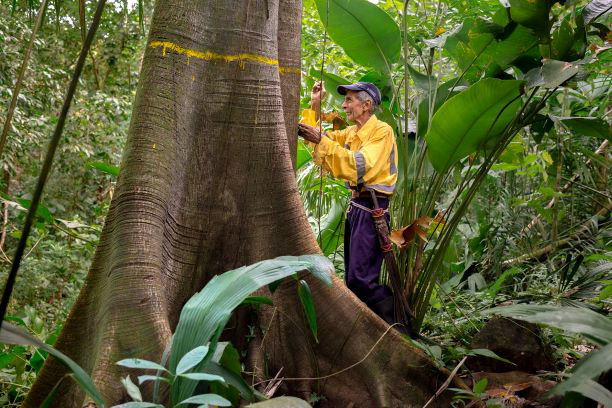Cycle 8 (2019 Deadline)
Incorporating relationships between ecosystem integrity and people’s livelihoods for conservation action planning in Tropical Dry Forest
PI: Susana Rodríguez-Buriticá (drodriguez@humboldt.org.co), Alexander von Humboldt Biological Resources Research Institute, in partnership with Universidad Nacional de Colombia
U.S. Partner: Andrew Hansen, Montana State University
Project Dates: January 2020 - August 2022
Twitter account: @inst_humboldt
Project Overview:
 | | | Dry forest group. Photo credit: Instituto Humboldt | |  | | | Photo credit: Felipe Villegas | |
Despite recent improvements in the availability of basic ecological information on Dry Tropical Forest (DTF) remnants in Colombia, high-impact conservation and sustainable land management strategies are still elusive. This is in part due to the lack of a comprehensive narrative connecting our ecological knowledge with the economic consequences of DTF degradation. This project will address two major knowledge gaps about DTF in Colombia. First, current basic research does not have a good characterization of DTF ecological degradation; specifically, forest degradation in terms of attributes that could be relevant for ecosystem services (ES) provision. Second, despite previous study of the ecological and socioeconomic aspects of DTF, no previous effort has aimed to integrate available information to produce a comprehensive understanding of the role of DTF for local communities, as well as the cost-benefits associated with DTF degradation and loss. Analyses of information have been limited by project-specific commitments and fall short in using sophisticated analytical tools to construct such a narrative. By translating the ecological impacts of DTF degradation on ES and cost-benefit valuations, this PEER team aims to provide powerful tools to negotiate DTF protection and restoration at the local levels.
The goal of the project is to integrate scalable information from contrasting DTF territories with nationwide integrity indicators and to improve models for ES supply dynamics and their economic assessments. Site-specific information for the project will come from two large current DTF projects supported by other sponsors that have explored the links between (1) multi-level biodiversity indicators and DTF degradation in nine watersheds and (2) DTF degradation, ecosystem processes, and ES supply in four watersheds, with only two with socioeconomic information. Both projects are based on forest ecological condition assessments that do not incorporate land management history and only consider forest extent, not forest structure or overall integrity.
PI Dr. Rodríguez and her PEER team will (1) evaluate the congruence between forest degradation, biodiversity, and ecosystem functioning and ES under contrasting socioecological contexts; (2) assess the role of landscape management history on the dynamic of forest and ecosystem degradation; and (3) use ecosystem valuation and cost-benefit analyses to assess relationships among alternative management practices. This PEER-supported project will update analyses and models to improve data integration, scalability, and applicability of results to other DTF contexts by using sub-products from several ongoing U.S. Government-funded projects that will improve landscape and forest degradation assessments, thereby generating stronger evidence-based, high-impact products with nationwide pertinence.
Final Summary of Project Activities
This project undertook a comprehensive review and integration of data spanning 2013 to 2022 from various projects involving the Humboldt Institute focused on dry tropical forests in Colombia. This effort consolidated information on biological composition, structure, and pressure dynamics affecting key forest remnants over time. By analyzing these patterns, the team identified distinct responses of DTF to anthropogenic pressures, categorizing forest remnants accordingly and emphasizing the importance of tailored conservation and restoration strategies. These findings are to be encapsulated in an upcoming book chapter series on DTF, alongside contributions exploring biodiversity impacts, invasive species risks, and acoustic landscape analysis.
Furthermore, the project integrated socioecological and socioeconomic data to assess the impact of forest management practices on DTF integrity at municipal scales, revealing a potential conflict between conservation efforts and local food security. Through Structural Equation Modeling (SEM), the team highlighted municipalities where environmentally friendly practices correlated with better forest conditions, contrasting with areas prioritizing self-supply practices which showed poorer forest integrity.
In addition to ecological assessments, the project modeled scenarios using Python's InVEST package to evaluate ecosystem services like water provision and regulation across DTF territories. Results underscored the critical role of forest cover in maintaining hydric dynamics, particularly during dry periods, and raised concerns about service vulnerability under climate change scenarios.
Ultimately, this project represents a milestone in synthesizing diverse datasets to provide a comprehensive narrative on DTF degradation and its implications for biodiversity and ecosystem services. By linking ground biodiversity data with remote sensing and socioeconomic variables, it advances understanding of DTF dynamics and informs strategic planning for sustainable management and restoration efforts in Colombia. Publications:
Rendón-Hurtado, N. D., Isaza-Narváez, C. V., & Rodríguez-Buriticá, S. (2020). Automatic Identification of Transformation in the Colombian Tropical Dry Forest Using GMM and UBM-GMM. Revista Facultad de Ingeniería, 29(54), e11752. https://doi.org/10.19053/01211129.v29.n54.2020.11752
Back to PEER Cycle 8 Funded Projects
|





